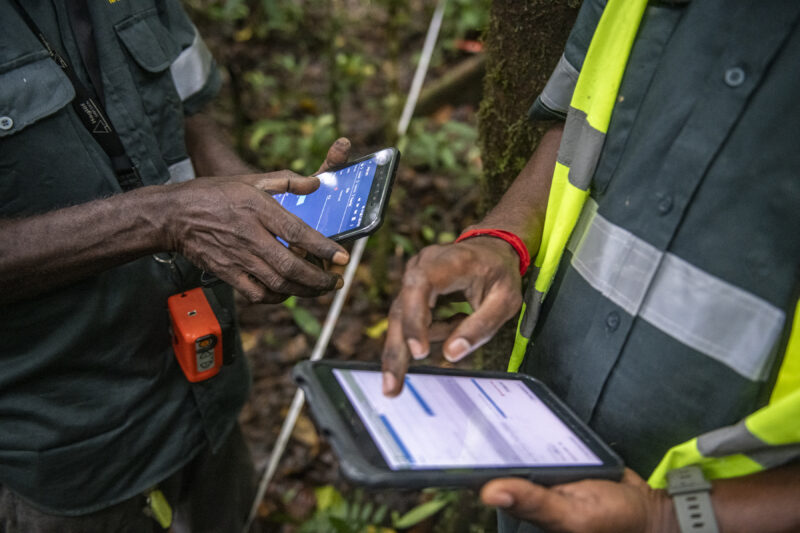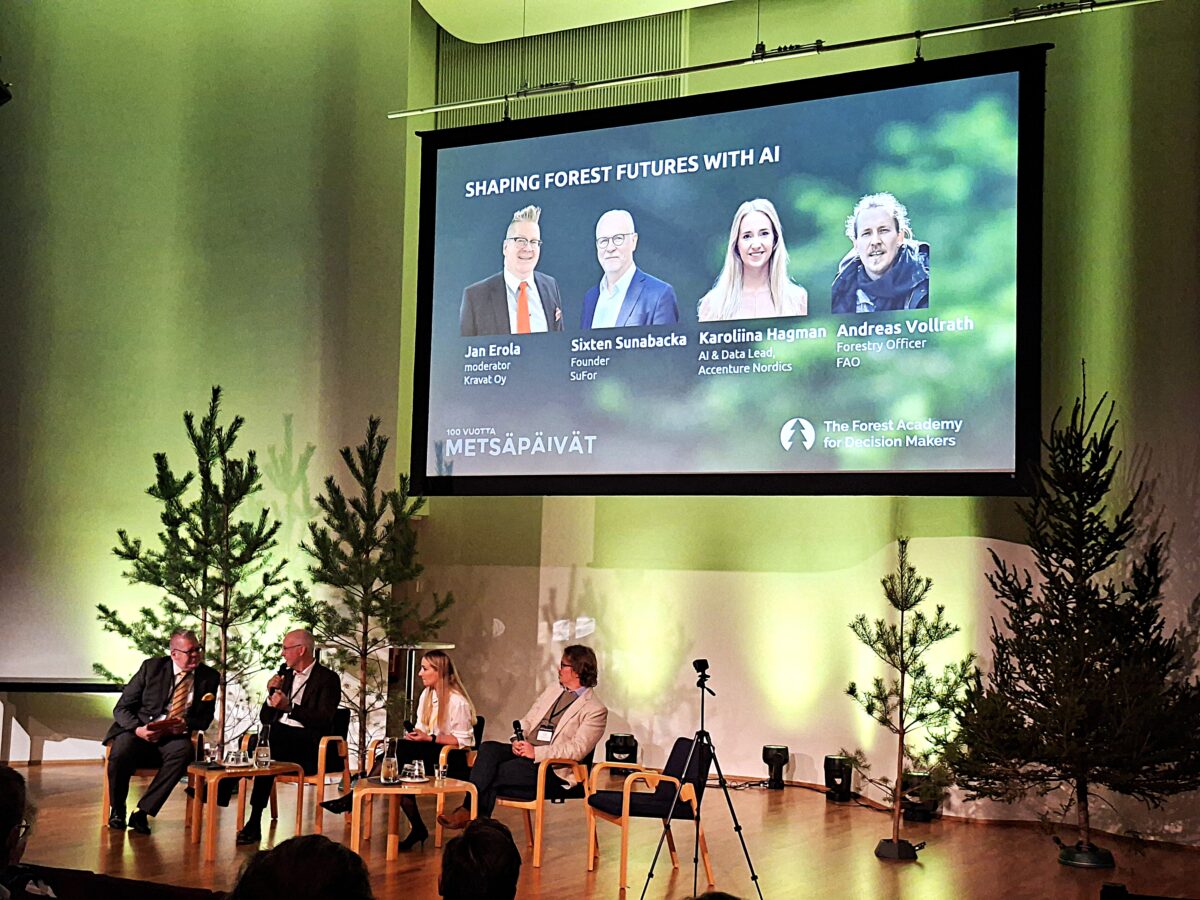FAO’s Andreas Vollrath: Artificial intelligence is revolutionising forest management worldwide

Artificial intelligence is rapidly reshaping forestry—from remote data collection to strategic decision-making. At Finland’s National Forest Days 2025, experts highlighted how digital tools have revolutionised forest monitoring in developing countries and paved the way for large-scale AI adoption.
“Just 10–15 years ago, forest data was collected in many countries using pen and paper,” recalled Andreas Vollrath, forestry expert at the Food and Agriculture Organisation of the United Nations (FAO).
“The introduction of digital tools, such as the Open Foris platform, has enabled developing countries to transition to electronic data collection and advanced remote sensing analysis, which opened the door to the large-scale use of artificial intelligence in forestry.”
On October 23, 2025, a panel discussion titled “Shaping Forest Futures with AI” was held at the Finnish Forest Days (Metsäpäivät) event at the Finlandia Hall in Helsinki. The event, organised by the Forest Academy for Decision Makers, explored, among other topics, the impact of artificial intelligence on the forest sector, from data collection to strategic decision-making.
The discussion highlighted the role of artificial intelligence in, for instance, forest inventorying, emissions reporting, and land use monitoring, as well as its growing importance in supporting policymaking and resource management.
Andreas Vollrath of the FAO, one of the three panel speakers, noted that artificial intelligence is only one part of a broader digital transformation evident in the forestry sector.
“The FAO has been using machine learning in remote sensing for a long time, but recent breakthroughs have significantly improved the way we access the data and turn it into valuable information,” he said.
According to Vollrath, a particularly promising development is the use of AI-powered embedding fields, which allow vast amounts of satellite data to be condensed into easily searchable formats.
“It works in much the same way as Facebook’s content recommendation feature, i.e., based on similarities,” explained Vollrath. “When you mark an area of deforestation, the system is able to immediately find similar patterns from around the world.”
Such models are opening new opportunities for forest monitoring, restoration, and policy support.

Artificial intelligence the forest industry value chain
Karoliina Hagman, Head of Artificial Intelligence and Data at Accenture Nordic, emphasised in the panel discussion the enormous, yet largely untapped potential of artificial intelligence in the forestry sector.
“Artificial intelligence is a huge change that affects all industries, and forestry is no exception,” she said.
Although forestry companies already use AI in areas such as human resources management, financial processes, and procurement, Hagman believes that the real opportunity lies in optimising the entire value chain.
She highlighted predictive maintenance, demand forecasting, and dynamic pricing as key areas of application where AI can bring significant added value by utilising methods that have already proven effective in manufacturing, logistics, and the mining industry.

Toward a new wave of forest intelligence
Sixten Sunabacka, Senior Advisor at MW Group AB—a Nordic company specialising in defence and security services—views Sweden as a frontrunner in applying artificial intelligence to forestry.
“Finland and Sweden have very similar starting points,” he noted, “but Sweden stands out with its vibrant startup ecosystem.” According to Sunabacka, venture capital support for AI-driven projects is stronger in Sweden, though Finland is beginning to catch up.
For him, the key question is whether artificial intelligence will spark the next major transformation in the forest sector.
“Looking back on four decades of development, the forest industry has moved forward in powerful waves. Artificial intelligence may well be the next one,” said Sunabacka, who also serves as Chairman of the Board at the Finnish geospatial technology company Arbonaut.
Sunabacka traced those waves: mechanisation in the late 1980s and early 1990s, with timber-measuring harvesters marking the actual breakthrough. In the 1990s, Nokia mobile phones and expanding mobile networks enabled decentralised forest information systems and optimised wood logistics.
By the early 2000s, growing competition for wood made reliable data on forest owners and timber resources essential, driving the transition from field inventories to LiDAR-based remote sensing.
“Soon, the entire country was scanned,” Sunabacka recalled, “and the quality of these scans improved further through the 2010s.”
The 2020s have brought new scanning technologies, drones (UAS), and sharper satellite imagery, he stated.
“Free satellite accuracy improved, making it especially useful for mapping forest losses and damages.”

Today, AI and machine learning are central to forest applications—but only with solid data, Sixten Sunabacka said.
“Even AI needs a huge amount of training material and accurate data. If you feed it garbage, you’ll get garbage out that only looks great.” High-density LiDAR and data from forest machines are, therefore, crucial, Sunabacka stressed.
Sweden is already testing scanners with 1,500 laser points per square meter, while Finland has chosen 20-point scanners for national use. In Sweden, progress is driven not just by the need for accurate forest data, but also by the desire to know more about individual trees, how easy the terrain is to move through, forest damage, biodiversity, and cultural values.
Sunabacka believes the convergence of dense scanning, UAS, AI and diverse data sources will soon provide “increasingly accurate, coherent, and broad information about our forests.”
Challenge of scaling AI in fragmented forest environments
Promoting artificial intelligence in forestry is not a one-size-fits-all solution, especially when ecosystems are fragmented and land ownership is decentralised.
“It all depends on who we work with and what the purpose of the work is,” Vollrath pointed out in the discussion.
Vollrath highlighted the global significance of Open Foris tools. Developed with Finnish funding and expert support, Open Foris is an open-source platform of the FAO, used for forest measurement, monitoring, and reporting in over 190 countries – mainly developing nations. It has become a key tool in, for example, REDD+ emissions reporting under the UN Climate Convention, and it has also brought forest data collection within reach of smallholders, using mobile devices.
For smallholders, the FAO is also developing easy-to-use mobile tools, such as WISP and Crown, to detect deforestation and report plantings in accordance with EU regulations.
“Collecting forest data using software is much easier than using pen and paper,” Vollrath said.
The audience at the Forest Days panel discussion brought an essential perspective to the debate: forests are messy, living systems, not spreadsheets. Vollrath agreed emphasising the importance of high-quality data. He noted that advances in LiDAR remote sensing technology enable reliable observations even in complex forest environments.
LiDAR (Light Detection and Ranging) is a laser-based technology that generates highly accurate three-dimensional models of terrain and vegetation. In forestry, it allows for precise mapping of tree structure, height, and density. By capturing millions of laser points from aircraft, drones, or satellites, LiDAR reveals forest details that are often invisible to the human eye or traditional field methods.
“When we have scientifically validated algorithms and accurate data at our disposal, we can trust what we see in the office. Only in special cases do we need to go into the forest,” Vollrath summarised.
Artificial intelligence and the forest sector in 2030
The panel ended with bold predictions for the next five to ten years. Experts predict that artificial intelligence will accelerate research and development work on new forest-based materials and more intelligent customer interaction, for example, through chatbots and agent-based user interfaces.
Artificial intelligence is also becoming increasingly prominent in production. Factories are already seeing a shift towards more efficient operations: fewer downtime incidents and higher quality. With AI and automation, production processes are being optimised, disruptions are being reduced, and quality control is being improved, which strengthens the competitiveness of the entire forest sector.
The panellists expressed the hope that artificial intelligence would soon surpass human capabilities in interpreting satellite imagery.
Although development has not yet reached that level, according to the panellists, artificial intelligence has significant potential to learn to visually perceive complex forest data more accurately and extensively, even better than humans. This could open new opportunities for global forest monitoring, analytics, and decision-making.
The discussion culminated in a call for deeper integration of AI into politics and the understanding of ecosystems. According to the panellists, artificial intelligence can offer new perspectives on how natural systems work, and generate added value not only for industry but also for society as a whole. This is particularly relevant in the Nordics, where forests are an integral part of everyday life and culture.